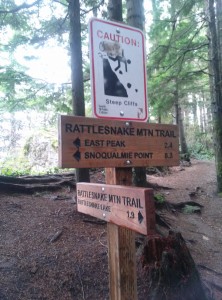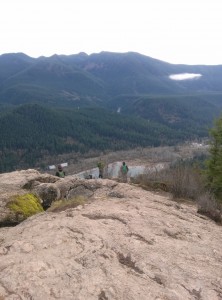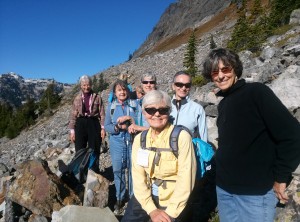Dear Gentle Reader,
In my last post, I talked about the pain of plantars faciitis along with some suggestions as to how to alleviate that debilitating pain. Today, I want to address the care of your feet, i.e. blisters and how to heal and prevent them.
Last Wed. Betty and I hiked 11 miles along Rattlesnake Ridge, overlooking North Bend, WA., a trail 45 minutes from Seattle. It is a through-hike requiring two cars. We chose the long uphill route dropping to the Ledge and thence to the lake below. Rattlesnake

ledge is infamous because so many unprepared people can easily get up there–it is only 1 1/2 miles, and every year one or two fall off to their death below.
In spite of arthritis, chronic pain, aching joints–hips, knees, ankles–, you still want to go walking. Your feet must have the best possible support. For me, this has been a huge challenge because I have bunions which require double wide men’s shoes. At one point I developed a metatarsal neuroma or Morton’s neuroma . I mentioned Dr. Huppin’s Foot and Ankle clinic last week. He knew exactly what modifications to make to the orthotic inserts to take the pressure off the 2nd toe and spread weight over all the toes.
He and his partner, Dr. Hale, publish a guide to shoes that helps a person choose the most stable shoe. They even consider and recommend a flip flop! Here’s the link where you can sign up for their recommended shoe list and guide lines on how to choose a shoe that will keep your foot stable.
On the Rattlesnake Ridge hike, I make a huge mistake. I ignore a hot spot between my big toe and the 2nd toe, a place where I have rubbed countless blisters. By the time I get home late that night, after another event, I can hardly walk.
I’d like to share what to do to avoid that suffering. Blisters are serious business. I knew a woman who ignored a blister her ski boot rubbed. It developed septicemia and she died before they could airlift her to a hospital.
In my pack I carry a tape made by a German company. The product is called Hansaplast and is not available in the US, only Canada and Mexico in North America. But of course anywhere in Europe you can purchase rolls of this magical thin, easy-to-tear-with-your-fingers tape. If I’m not going to Europe, I ask a traveling friend to buy it for me. Usually I put a piece of this tape on the areas of my feet most likely to blister in my hiking boots before I begin the hike. Usually, if I feel a hot spot, the way I did when we hiked out of Commonwealth Basin up the Pacific Crest Trail toward Red Pass, I stop on the trail and take off my boots and sox and put the tape on, thus preventing a blister. But on Rattlesnake Ridge, I ignored everything I usually do.
The blister kept me awake all night. In the morning I punctured it, cleaned it carefully and put Second Skin on it. This is the second thing to tell you about blisters. Second Skin is a must for your pack first aide kit. Don’t leave home without it. You leave the second skin on for 5 days and by that time the blister is completely healed. I hiked again yesterday, 8 miles on Tiger Mt. with quite an elevation gain. Before going, I used the Hansaplast and a pair of liner sock.No blisters or sore feet.
One more suggestion for protecting your feet and legs: walk with hiking sticks and use them to lift your body up and lower it down on the steep bits of trail. Your upper body gets a work out and your legs and feet have less stress. We spent much of our time on Tiger a little bit lost. I was glad we were 5 and that my smart phone GPS could locate us, but nothing helped poor signage. We are determined to master the maze of wilderness trails on this complicated mountain, a foot hill of the Cascade Range, blessedly protected by forward looking environmentalists. Known as the Issaquah Alps, Tiger and Cougar and Squak mountains form a corridor of wilderness in an otherwise densely developed exurban Seattle.
More than anything, keep moving, Gentle Reader, keep moving.
Before you go, what is your foot sore story and how have you kept sore feet from keeping you in your chair? Let us hear from you.
Be well, Do well and keep moving
Betsy
206-933-1889
e may


